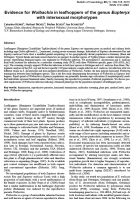Evidence for Wolbachia in leafhoppers of the genus Eupteryx with intersexual morphotypes
Henke C., Nickel H., Scheu S., Schäfer I. 2013. Bulletin of Insectology 66 (1): 109-118.

Abstract
Leafhoppers (Hemiptera Cicadellidae Typhlocybinae) of the genus Eupteryx are important pests on medical and culinary herbs including sage (Salvia officinalis L., Lamiaceae), causing severe economic damage. Individuals of Eupteryx decemnotata Rey and Eupteryx melissae Curtis show a modified genital morphology at two geographically distant populations in Germany (Bonn and Göttingen). Typical female and male sexual characters are merged. In another species of Typhlocybinae a similar intersexual phenotype, representing feminized males, was explained by Wolbachia infection. We investigated E. decemnotata and E. melissae from both locations for infection by a molecular screening study (PCR) with three Wolbachia specific genes (16S rRNA, ftsZ, wsp). The screening strongly supports Wolbachia infections in both host species in Göttingen and in E. melissae from Bonn. Phylogenetic analyses of the ftsZ, wsp and the host-specific COI gene indicate a single infection in E. melissae, but infection with two different strains in E. decemnotata and host-mediated distribution of Wolbachia. Further, the data indicate horizontal Wolbachia transmission between these leafhopper species. This is the first study demonstrating the presence of Wolbachia in Eupteryx leafhoppers. Rapid spread of Wolbachia in Eupteryx populations can potentially threaten sage cultivations if morphologically modified individuals represent feminized males, thereby increasing the reproductive potential of infected populations. We discuss possible implications of Wolbachia infection inducing a feminoid phenotype for the population dynamics of leafhopper pests.
Keywords: feminization, reproductive parasites, horizontal transmission, molecular screening, plant pest, medical herbs, spice herbs, Wolbachia supergroup.
Download
Evidence for Wolbachia in leafhoppers of the genus Eupteryx with intersexual morphotypes


